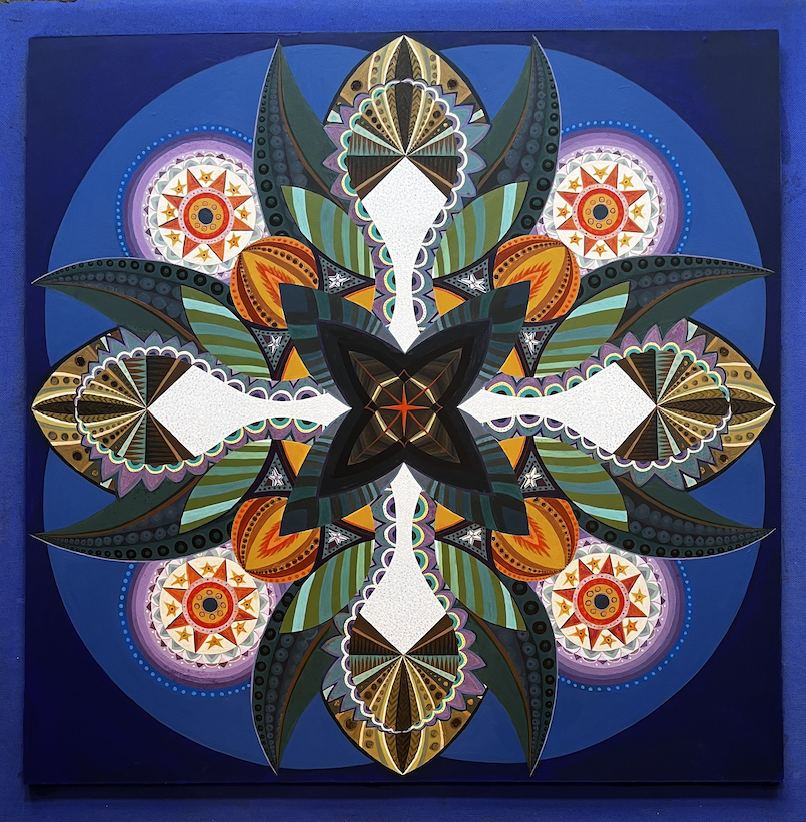Victor Bramley
Born 16th November 1933 Sheffield, Yorkshire ~ Died 19th June 2014 Penzance, Cornwall

Victor Bramley moved to St Ives in 1959, achieving recognition for his skills in painting landscapes and still-life compositions. He was elected a member of the St Ives Society of Artists in 1961 and remained a loyal member for sixty years.
In 1964, Bramley and his wife Jacque Moran moved to Nancledra, a village between St Ives and Penzance, where he used the village mill as his studio.
In 1967 Bramley took up yoga, which became a catalyst for a radical change in his art. He began to create intricate mandala drawings and paintings. They were first exhibited in 1974 at The Orion Gallery, which was the year the gallery amalgamated with the nearby Newlyn Gallery where Ithell Colquhoun also exhibited, showing her well known Taro series in 1977.
The following text is from the original Victor Bramley catalogue for the Orion Gallery show in 1974.
“Manadalas: Cammann suggests that mandalas were first brought to Tibet from India by the great Guru Padmasambhava in the 8th Century. They are to be found all over the Orient and are always a guide to contemplation and concentration – as an aid in inducing certain mental states and in encouraging the spirit to move forward along its path of evolution from the biological to the geometric, from the realms of corporeal form to the spiritual”, Mercia Eliade has written, “Literally, the word Mandala means ‘circle’: the Tibetan translation renders it by ‘centre’ or ‘that which surrounds’. It is in fact a complex design, comprising a circular border, or one or more concentric circles enclosing a square divided into four triangles; in the centre of each triangle and in the centre of the mandala itself are other circles containing divinities or their emblems. This iconographic scheme is susceptible to countless variations; some mandalas look like labyrinths, others like palaces with ramparts, towers, gardens; we find floral patterns side by side with crystallographic structures and sometimes the diamond or the lotus blossom is discernible.
The functions of the mandala, like that of the labyrinth are twofold at least. On the one hand, entrance to a mandala drawn on the ground is equivalent to an initiation, on the other, the mandala ‘defends’ the disciple against any destructive force and at the same time helps him to concentrate, to find his own ‘centre’. The mandala then can be regarded as a symbol of paradise.” Victor Bramley, 1974
A favourable review in the Western News stated “Sit and study one for a few moments only and its kaleidoscope of shapes and rich colours
begins to move. Flowers open, castles and palaces appear, secret paths beckon, and one is completely lost. Their therapeutic value must be considerable. This is the first time these have been, shown, they impress enormously and are well worth a visit.”
A recent article on Victor Bramley can be read on artcornwall.org
Selected Exhibitions:
1967 ~ Solo show at Penwith Gallery, St Ives
1968 ~ Solo show at the Woodstock Gallery, London
1969 ~ Solo show at Devonshire House, Exeter University
1970 ~ Penlee House, Penzance
1974 ~ Mandalas ~ The Orion Gallery, Penzance
2025 ~ Tranceducers: Art of Visionaries, Mediums and Automatists ~ GPS Gallery, London
